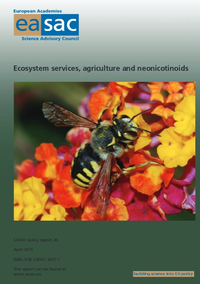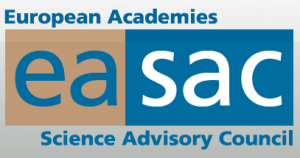
Neonicotinoides : El Consejo Científico de la UE pide una revisión exhaustiva, además de los efectos sobre las abejas
 El Consejo Científico de la Unión Europea, Noruega y Suiza, declara que o foco nas abelhas vem distorcendo o debate sobre o uso dos neonicotinóides. Segundo a EASAC“há mais e mais evidências de que o uso amplo desta classe de pesticidas tem efeitos severos sobre um amplo conjunto de organismos que oferecem serviços ecossistêmicos de polinização e controle natural de pragas, assim como sobre a biodiversidade.”
El Consejo Científico de la Unión Europea, Noruega y Suiza, declara que o foco nas abelhas vem distorcendo o debate sobre o uso dos neonicotinóides. Segundo a EASAC“há mais e mais evidências de que o uso amplo desta classe de pesticidas tem efeitos severos sobre um amplo conjunto de organismos que oferecem serviços ecossistêmicos de polinização e controle natural de pragas, assim como sobre a biodiversidade.”
A atenção pública e política exclusivamente sobre o problema do declínio das abelhas tira a atenção sobre as inúmeras outras espécies que vêm sendo atingidas. Sintetizam ainda que “apenas a proteção às abelhas não será suficiente para garantir uma agricultura sustentável”, e apresentam 4 conclusões centrais:
1) Há um conjunto crescente de evidências de que o amplo uso profilático dos neonicotinoides tem efeitos negativos severos sobre outros organismos (não-alvo), que oferecem serviços ecossistemicos, tal como a polinização e o controle natural de pragas;
2) Há claras evidências científicas para efeitos sub-letais em muito baixos níveis de aplicação de neonicotinoides por períodos prolongados em organismos não-alvo, o que deve ser considerado nos novos procedimentos de aprovação de pesticidas da Comunidade Econômica Europeia.
3) As práticas correntes do uso profilático dos neonicotinoides são inconsistentes com os princípios básicos do manejo integrado de pragas, como expressos nas Diretivas de Uso Sustentável de Pesticidas da UE;
4) O amplo uso de neonicotinoides (assim como de outros pesticidas) restringe o potencial de recuperação da biodiversidade no campo.
Estes temas centrais serão alvo de um debate amplo e aberto durante evento na EASAC, nesta 2a. feira, 13/04/15, em Bruxelas. O pano de fundo desta discussão é o fim do período de moratória do uso dos neonicotinóides na Europa, cujo período de 2 anos se encerra em Dezembro de 2015.
Confira abaixo a nota completa publicada no site e acesse o recém editado documento (Servicio de Ecosistemas, Agricultura y neonicotinoides) que fundamenta este parecer.
Neonicotinoids: European Science Academies call for debate that expands beyond bees | 08.04.15
Fuente: http://www.easac.eu/home/press-releases/detail-view/article/neonicotinoi.html
A focus on honey bees has distorted the debate around neonicotinoids. But there is more and more evidence that widespread use of neonicotinoids has severe effects on a range of organisms that provide ecosystem services like pollination and natural pest control, así como sobre la biodiversidad. These are the main conclusions of a new report published today by the European Science Academies (EASAC).
EASAC is the European Academies Science Advisory Council, a network of the national science academies of the EU Member States, Norway and Switzerland. In the wake of the Commission’s 2013 regulation restricting some uses of neonicotinoids to protect bees, EASAC assembled 13 leading experts to review the science.
Public and political attention has focused on whether honey bee colonies are being affected by neonicotinoids. But studying honey bee colony numbers does not show what is happening to the many other species providing the ecosystem services of pollination, natural pest control, soil productivity or the underpinning of biodiversity. Honey bees are just one pollinator – others include bumble bees, solitary bees, hoverflies, butterflies and moths. Other pollinators have generally declined across Europe as honey bee colony numbers have fluctuated.
In addition, honey bee colony structure provides a buffer against losses of foragers and workers, which is overlooked by many studies looking at the impact of neonicotinoid use on honey bee colony survival. In contrast, bumble bees have much less buffering capacity – and solitary bees none at all. Protecting honey bees is not enough to ensure sustainable agriculture.
In assessing the effects of neonicotinoids on non-target organisms, EASAC’s report comes to four key conclusions:
- There is an increasing body of evidence that the widespread prophylactic use of neonicotinoids has severe negative effects on non-target organisms that provide ecosystem services including pollination and natural pest control.
- There is clear scientific evidence for sub-lethal effects of very low levels of neonicotinoids over extended periods on non-target organisms, which should be addressed in EU approval procedures.
- Current practice of prophylactic usage of neonicotinoids is inconsistent with the basic principles of integrated pest management, as expressed in the EU’s Sustainable Pesticides Directive.
- Widespread use of neonicotinoids (as well as other pesticides) constrains the potential for restoring biodiversity in farmland.
Some intensive agriculture has become reliant on neonicotinoids, with proponents arguing that their withdrawal would have serious economic and food security implications. However, EASAC notes that some recent research has questioned the benefits of routine use as seed dressing against occasional or secondary pests. In some cases, neonicotinoid use has even made pest problems worse by eliminating insects which provided natural pest control.
As the EASAC report acknowledges, all pesticides involve a balancing act between the desired effect on food production and the inevitable risk of collateral damage to non-target species and the environment. In the case of the neonicotinoids, the increase in scientific knowledge over the last two years suggests that the current balance requires reassessment.
These conclusions will be discussed in an open debate with stakeholders at an EASAC event in Brussels on Monday 13 abril. You can register for this event here.
Notes for Editors
Political coverage focuses very much on possible effects of neonicotinoids on honey bees, but EASAC thinks the key question should be on the effects on a range of critical ecosystem services to agriculture. These include:
– Pollination: worth �14.6 billion in Europe and where there is already a deficit (insufficient pollinators for the crops in flower) in some parts of Europe. Bees are often the most important crop pollinators but EASAC concludes that relying on a single species for pollination is not wise and restoring and maintaining pollinator diversity is very important for agriculture as well as for natural vegetation.
– Natural pest control: where predatory insects (parasitic wasps, ladybirds, some beetles, etcétera) and birds consume pests sufficiently to avoid the need for chemical measures – estimated to be worth US$100 billion annually globally.
– Soil organisms and their role in protecting and enhancing agricultural productivity.
– Underpinning these services is biodiversity, which is also a policy objective in its own right under EU and global agreements.
How these services are trending was a critical question which the report notes has tended to focus on honey bees in the political debate. However, determining trends in honey bee colonies is confounded by many factors other than agricultural practice (weather, price of honey, hobby trends and so on), and colony numbers thus fluctuate a lot. To measure wider trends, EASAC looked at data on wild bee species, other pollinators, insect species with natural pest control functions and biodiversity indicators such as farmland birds. These all show major declines in recent decades.
Declines are, sin embargo, due to many factors which operate at the landscape level and the level of the individual field, as well as factors that affect individual species (such as honey bee parasites and diseases). Separating out any additional influence which arises from neonicotinoids use is thus not straightforward. EASAC looked at how the presence of neonicotinoids in a plant renders it toxic for pest insects, but also the risk that residues in pollen, nectar and other fluids may affect species not targeted and the possibility of transmission through the food chain (e.g. bees foraging on aphid honey dew, predators exposed through ingesting prey).
EASAC reviewed the scientific literature, including over 100 papers published in the last 2 years, to develop its overall assessment of the effects of neonicotinoids on non-target organisms.
EASAC is formed by the national science academies of the EU Member States, Norway and Switzerland, to collaborate in giving advice to European policy-makers. EASAC provides a means for the collective voice of European science to be heard. Through EASAC, the academies work together to provide independent, expert, evidence-based advice about the scientific aspects of European policies to those who make or influence policy within the European institutions.
The full report can be downloaded from here.
The Report’s launch on the EASAC website coincides with an article by EASAC’s Chair of the Working Group Professor Peter Neumann inNaturaleza.
Contacts
EASAC Environment Programmes Director Professor Mike Norton
michael.norton@easac.eu
Tel: +44 1763 853130
Head of EASAC Brussels Office Sofie Vanthournout
brusselsoffice@easac.eu
Tel: +32 2 550 23 32


Apenado, el formulario de comentarios está cerrado en este momento.